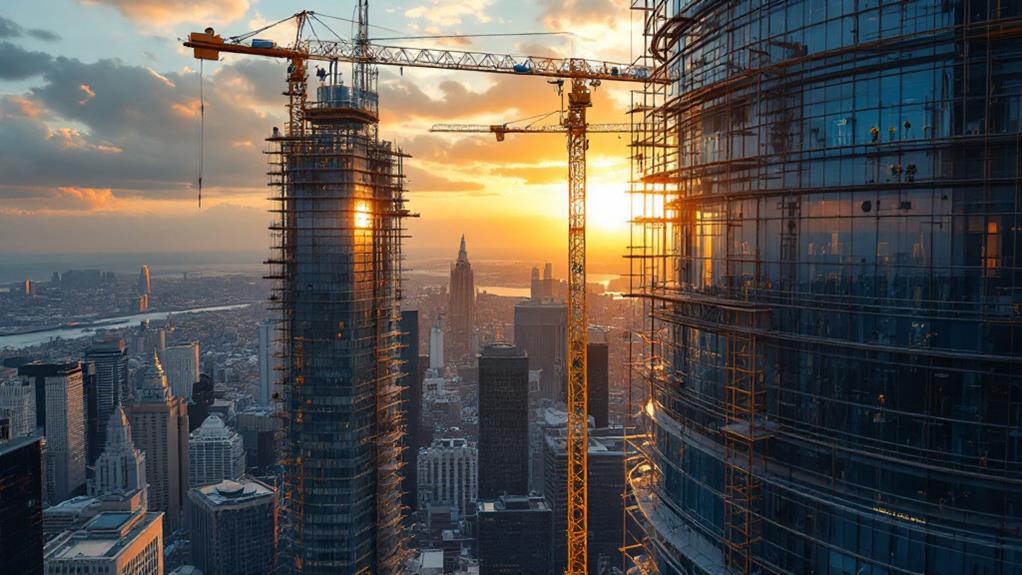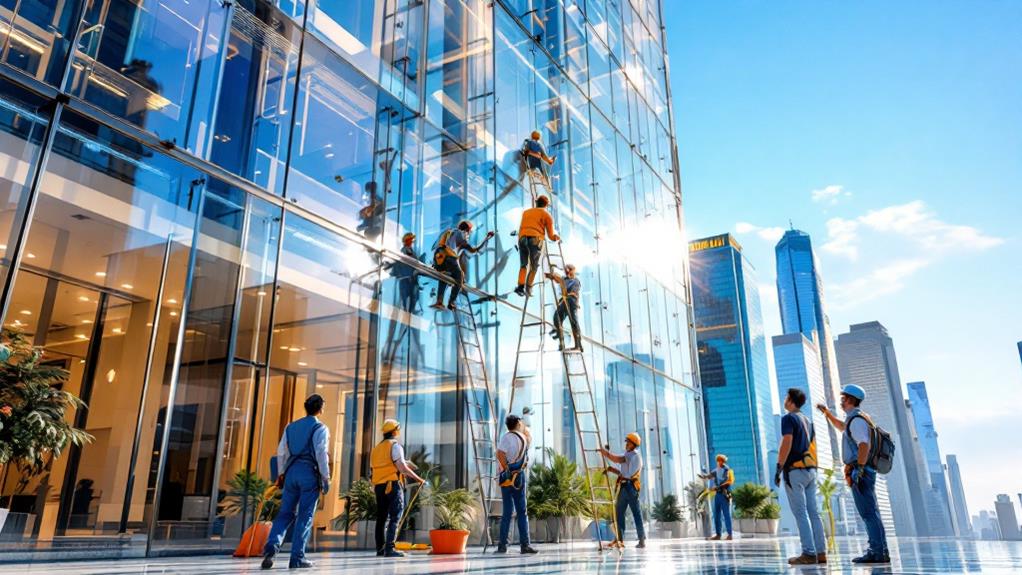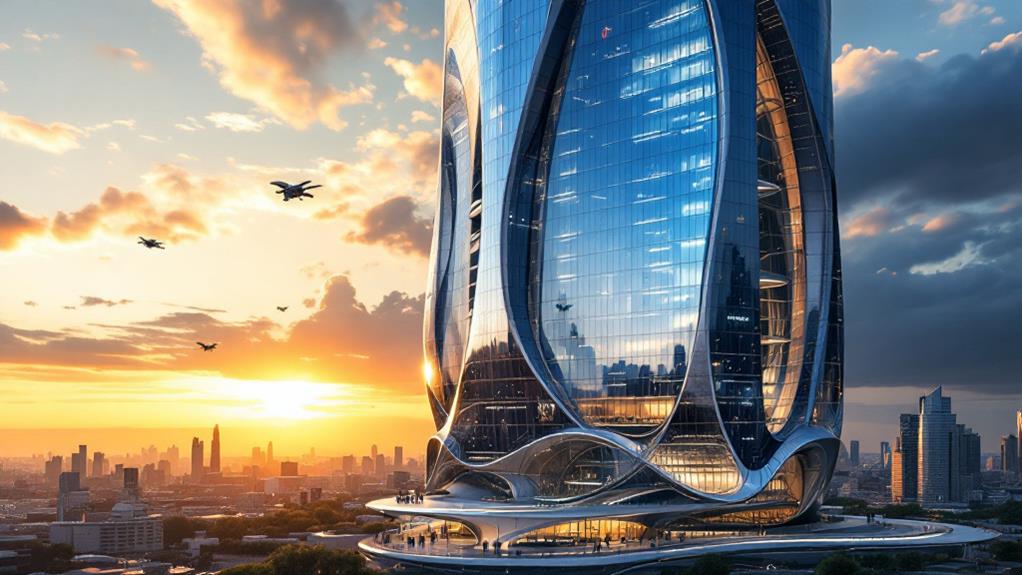What It Takes to Maintain the Largest Buildings in the World

Maintaining the largest buildings in the world, like the Burj Khalifa, demands significant resources and planning. You'll need a dedicated team of up to 300 interior cleaners and 36 abseilers to tackle its immense size. Cleaning the exterior alone might take a window team four months. Advanced technologies, such as AI and robotic solutions, streamline upkeep tasks. The massive daily energy consumption, around 160,000 kWh, requires careful monitoring. Crucial facilities like high-speed elevators contribute to the complexity. Embracing automation and smart technologies can improve efficiencies and safety. There's much more depth to this monumental maintenance puzzle.
Understanding Building Magnitude
Understanding the magnitude of the world's largest buildings is essential for grasping the complexities involved in their maintenance. When you think about the tallest building, the Burj Khalifa certainly comes to mind. It stands at an astonishing height of 829.8 meters (2,722 feet), making it the tallest building in the world. This skyscraper doesn't just soar into the sky; it also boasts 20,434 windows, covering approximately 1.29 million square feet, equivalent to about 22 football fields or 17 soccer fields. Imagine the challenge of keeping such a vast area pristine and presentable.
The Burj Khalifa's construction took a detailed five years, highlighting the incredible planning and resources necessary to maintain it today. With over 800 residential apartments and 37 office floors, your maintenance efforts must be relentless to guarantee the building maintains its luxurious image. You need to take into account the building's unique design, which includes a spire and numerous levels. These features add complexity to maintenance tasks, demanding specialized equipment and a skilled workforce, particularly for window cleaning. Understanding the enormity of these tasks helps you appreciate the dedication required to preserve the grandeur of the Burj Khalifa.
Maintenance Challenges and Solutions
Maintaining the Burj Khalifa is no small feat, requiring a strategic approach to address its unique challenges. High-rise buildings like this one present significant maintenance challenges due to their sheer size and complexity. For instance, the Burj Khalifa's 20,434 windows cover an area of 1.29 million square feet, demanding a team of 300 interior cleaning workers and 36 exterior abseilers. It takes them four months to complete a full cycle of exterior cleaning four times a year, underscoring the labor-intensive nature of skyscraper maintenance.
Energy consumption is another challenge. The Burj Khalifa uses approximately 160,000 kWh daily, making continuous energy monitoring crucial to guarantee efficiency. This requires advanced technology, including AI and machine learning, integrated into maintenance management software. These tools improve operational efficiency and responsiveness, helping to address maintenance needs swiftly.
Waste management in a high-rise building is also complex. The Burj Khalifa employs a 1,300-meter-long chute system transporting waste at 194 km/h, an groundbreaking solution for handling waste disposal efficiently. By embracing such technologies and strategies, you can effectively manage the maintenance challenges posed by high-rise buildings, confirming they operate smoothly and sustainably.
Interior and Exterior Facilities

The Burj Khalifa stands as a marvel of modern engineering, with its interior and exterior facilities offering both luxury and functionality. As one of the world's largest buildings, it boasts 800 apartments, 37 office floors, and the 304-room Armani Hotel across 15 floors, creating a lively mix of residential and commercial spaces. Moving between its numerous levels is seamless, thanks to 57 elevators and 8 escalators, which can travel at impressive speeds of up to 10 m/s.
Inside, the building's thorough waste management system features a 1,300 m long chute, allowing waste to be swiftly disposed of at speeds of 194 km/h. This guarantees that the building's interior remains as pristine as its exterior. Speaking of exteriors, maintaining the Burj Khalifa's facade is no small feat. A dedicated team of 36 abseilers and 18 specialized buckets work tirelessly to preserve its luxurious appearance.
Moreover, the At.Mosphere restaurant and the observation deck provide breathtaking views, enhancing the Burj Khalifa's reputation as a premier destination for dining and tourism. Together, these interior and exterior facilities make the Burj Khalifa unparalleled in its grandeur and efficiency.
Workforce and Management Roles
A robust management system guarantees the seamless operation of the Burj Khalifa's massive facilities. Led by Senior Director Bashar Kassab, the centralized management approach guarantees high standards of service and operational efficiency. The workforce plays a significant role in maintaining the building's luxury image, with 300 interior cleaning workers and 36 exterior abseilers covering an area equivalent to Great Britain annually. Management roles involve coordinating extensive cleaning operations, securing safety measures, and leveraging technology for maintenance.
In this environment, every role counts, and here's how the team keeps the Burj Khalifa pristine:
- Workforce of 300 interior cleaners: They're fundamental for the building's daily upkeep.
- 36 exterior abseilers: They brave high altitudes with safety restraint systems.
- Window cleaning team of up to 120: They complete exterior cleaning in 3-4 months.
- Advanced maintenance management software: It optimizes response and accuracy.
- AI and machine learning: These technologies improve operational sophistication.
The synergy between workforce and management roles is crucial for success. By prioritizing safety and utilizing advanced technology, the Burj Khalifa sets a high standard for building maintenance, securing both efficiency and luxury.
Innovations in Cleaning Technology

Cutting-edge robots are transforming how we approach skyscraper maintenance. In the construction industry, innovations in cleaning technology are vital for improving both efficiency and safety. While most current robotic cleaning technologies, like the Hobart 298 and Buh-bah Twin 660, are designed for smaller residential use, significant advancements are underway. Companies like Skyline Robotics are at the forefront, developing sophisticated robots capable of tackling the formidable task of cleaning massive skyscrapers, including iconic structures like the Burj Khalifa.
The Osmo robot is a game-changer, employing reverse osmosis technology for chemical-free cleaning, which not only reduces environmental impact but also streamlines the high-rise maintenance process. These innovations are poised to reduce labor costs and improve safety by automating dangerous tasks traditionally performed by human workers dangling from dizzying heights.
In regions like the UAE, where high-rise construction is booming, the demand for specialized robotic cleaning solutions is increasing. As these technologies evolve, you'll likely see more companies focusing on developing advanced robotic systems to meet this growing need. Embracing these innovations in cleaning technology is fundamental for the construction industry to maintain its tallest and most ambitious projects efficiently and sustainably.
Future Trends in Skyscraper Maintenance
As skyscraper maintenance evolves, you're witnessing a fascinating shift toward automation and smart technologies that promise to redefine how these towering structures are cared for. The increasing height and complexity of modern skyscrapers demand creative solutions, and robotic window cleaning solutions are at the forefront of this transformation. Companies like Skyline Robotics are leading the charge, creating systems that not only reduce labor costs but also improve safety by minimizing the need for human workers in precarious positions.
Advanced technologies such as AI and machine learning are being integrated into maintenance management software, allowing for quicker response times and more precise solutions to building issues. This evolution means more efficient maintenance strategies tailored to each building's unique needs. As the number of high-rise buildings continues to grow, especially in regions like the UAE, there's a vast opportunity for firms specializing in robotic maintenance solutions to make their mark.
Here's what you can expect in the future of skyscraper maintenance:
- Increased use of robotic window cleaning solutions
- Integration of AI in maintenance management
- Tailored strategies leveraging automation
- Improved safety measures
- Collaborations between tech firms and building managers



